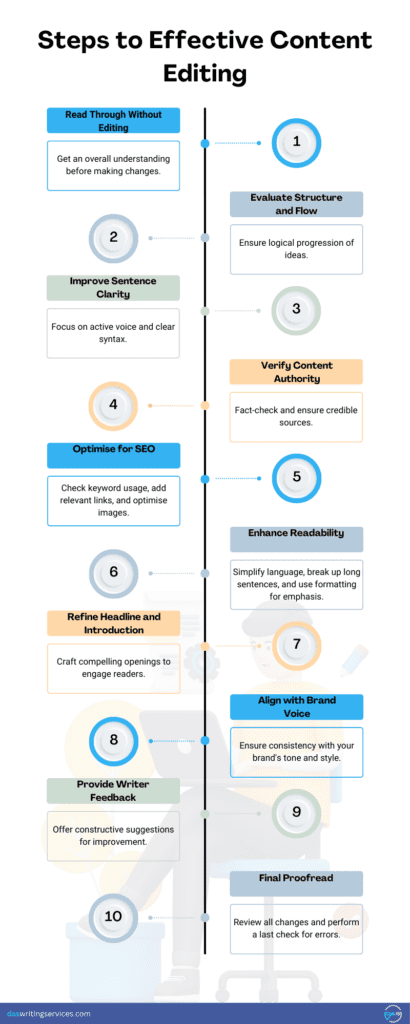Do you want to make your content stand out in the overcrowded world of internet?
In the flood of generic thin content, creating high-quality and engaging material is essential if you want to connect with the target audience effectively.
But, great content does not just happen! It requires tireless efforts of a writer followed by a meticulous editing process to ensure clarity, accuracy, consistency, and adherence to best practices. This comprehensive guide goes deep into the fundamentals ofcontent editing and the various tricks and techniques involved in transforming ordinary content into an extraordinary masterpiece.
Let’s jump in!
Understanding the Content Editing Process
Content editing is a multifaceted process that involves evaluating and refining written material to enhance its overall quality, readability, and impact for content marketing.
A content editor does not only fix typos and grammar, they play a key role in shaping the content to effectively communicate its message, engage readers, and achieve its desired objectives. One may do so by revising the structure of the content, rearrange the order of the information or adding more data and figures. In essence, editing makes a content more engaging and easy to understand.
Steps to Effective Content Editing
Effective content editing is a multistep process that requires careful planning, attention to detail, and a systematic approach. Here are the key steps to ensure a comprehensive and effective editing process:

- Read Through Without Editing: Get an overall understanding before making changes.
- Evaluate Structure and Flow: Ensure logical progression of ideas.
- Improve Sentence Clarity: Focus on active voice and clear syntax.
- Verify Content Authority: Fact-check and ensure credible sources.
- Optimise for SEO: Check keyword usage, add relevant links, and optimise images.
- Enhance Readability: Simplify language, break up long sentences, and use formatting for emphasis.
- Refine Headline and Introduction: Craft compelling openings to engage readers.
- Align with Brand Voice: Ensure consistency with your brand’s tone and style.
- Provide Writer Feedback: Offer constructive suggestions for improvement.
- Final Proofread: Review all changes and perform a last check for errors.
The Importance of Content Editing for SEO
High-quality content creation requires a vigilant and inquisitve mind to make sure your content has its own spark. And it all begins with content editing to deliver a polished and professional message. Editing is also important if you want to get the most with search engine optimisation writing (SEO). Here are some key reasons why editing is crucial for SEO:
Enhancing Clarity
Clear and concise content is essential for both human readers and search engines to understand the message effectively. Editing helps remove ambiguity, simplify complex ideas, and ensure that the content communicates its message clearly and directly.
Ensuring Accuracy and Credibility
Inaccurate or outdated information can undermine the credibility of your content and negatively impact your search engine rankings. Editing ensures that the facts, statistics, and claims presented in your content are accurate, up-to-date, and supported by reputable sources.
Maintaining Consistency
Consistent use of terminology, tone, and style is crucial for creating a cohesive and professional brand image. Content editing helps maintain consistency across all your content, ensuring that your brand voice and messaging remain consistent, regardless of the author or topic.
Tailoring Content for the Audience
Understanding your target audience is essential for creating content that resonates with them. Editing allows you to tailor your content to the specific needs, interests, and language preferences of your target audience, improving engagement and increasing the likelihood of conversions.
Language and Grammar
Poor grammar, spelling, and punctuation errors can undermine the credibility of your content and make it difficult to read. Editing ensures that your content adheres to proper language conventions, making it more accessible and professional.
Structure and Organisation
Well-structured and organised content is not only easier to read but also helps search engines understand the content better. Editing involves restructuring and reorganising content to improve flow, logical progression, and overall comprehension.
Style and Tone
The style and tone of your content play a significant role in shaping the reader’s perception and engagement. Content editing allows you to adjust the style and tone to align with your brand voice, target audience, and desired message.
Fact-Checking and Research
Accurate and well-researched content is crucial for establishing trust and credibility with your audience. Editing involves fact-checking claims, verifying statistics, and ensuring that reliable sources support the information presented.
Engagement and Readability
Engaging and readable content is more likely to capture and retain the reader’s attention. Editing focuses on improving readability by breaking up dense paragraphs, using subheadings, incorporating visual elements, and employing storytelling techniques to make the content more engaging and digestible.
Copy Editing vs. Content Editing: What is the Difference?
Copy editing and content editing are distinct processes with different objectives. Here is a table to help you understand the key differences:
| Factors | Copy Editing | Content Editing |
| Focus | Correcting grammar, spelling, punctuation, and formatting errors | Evaluating and refining the content itself, including structure, messaging, and alignment with goals |
| Scope | Copy editor focuses on the mechanics of writing | content editor focuses on the substance and overall quality of the content |
| Objective | Ensures adherence to style guides and conventions | Ensures the content effectively communicates its message and resonates with the target audience |
| Level of Editing | Surface-level corrections | In-depth revisions and improvements |
| Typical Tasks | Fixing typos, inconsistent capitalisation, incorrect word usage, etc. | Reorganising information, rewriting sections, adjusting tone and style, fact-checking, etc. |
While copy editing is an essential step in the editing process, editing takes a more strategic approach, addressing the written material’s overall quality, effectiveness, and impact.
5 Popular Types of Content Editing
Content editing encompasses various sub-categories, each serving a specific purpose and addressing different aspects of the written material. Understanding the different types of editing is crucial to produce high quality content that satisfies user search intent. Here are the main types of content editing:
Developmental Editing
Developmental editing is typically the first stage and involves a comprehensive evaluation of the content’s overall structure and messaging. It focuses on addressing major issues, such as inconsistencies in the narrative, and information gaps, and ensuring that the content aligns with the intended goals and target audience.
Developmental editors may suggest significant revisions, reorganisation, or even rewriting sections to improve the overall quality and effectiveness of the content.
Copy Editing
As mentioned earlier, copy editing focuses on correcting errors in grammar, spelling, punctuation, and formatting. It ensures that the written material adheres to established style guides and conventions, maintaining consistency and professionalism throughout the content.
Line Editing
Line editing is a more detailed form of editing that examines the content line by line. It involves improving the writing’s clarity, flow, and effectiveness at the sentence and paragraph level. Line editors may rephrase or restructure sentences, eliminate redundancies, and ensure that the language is concise and engaging.
Proofreading
Proofreading is the final stage of the editing process and involves a thorough review of the written material to catch any remaining errors or inconsistencies. Proof readers carefully check for typos, spelling mistakes, missed punctuation, and formatting issues that may have been overlooked in previous editing stages.
SEO Editing
SEO editing is a crucial component of content search engine optimisation. It involves evaluating and optimising the content for specific keywords, ensuring that the content is structured and formatted to make it easily discoverable and readable for search engines.
SEO editors may suggest changes to headings, meta descriptions, alt text, and internal linking to improve the content’s search engine visibility and rankings.
How to Develop Editing Skills Like a Pro?
Writing and editing both are complementary skills that helps in the other. There is a reason why all good editors have mostly been a writer sometime. Becoming a skilled content editortakes time, practice, and a commitment to continuous learning. Here are some strategies to help you develop the skills of a good content editor:
Develop a Deep Understanding of Grammar Rules
A solid grasp of grammar rules is the foundation in the process of editing. Invest time in studying grammar guides, taking courses, or attending workshops to deepen your understanding of grammar concepts, such as parts of speech, sentence structure, punctuation usage, and common errors to watch out for.
Hone Your Attention to Detail
Successful editing requires an exceptional eye for detail. Train yourself to identify even the smallest errors, inconsistencies, or areas for improvement. Practice proofreading techniques, such as reading content backwards or out loud, to enhance your ability to catch mistakes that may otherwise go unnoticed.
Read Extensively and Critically
Reading a diverse range of well-written content can help you develop a keen sense of what constitutes effective writing. As you read, analyse the author’s writing style, word choice, sentence structure, and overall flow. This critical analysis will help you identify techniques and strategies you can incorporate into your own editing practices.
Practice Editing in Various Contexts
Editing skills are honed through practice, so seek out opportunities to edit different types of content, such as website blogs, articles, reports, websites, and marketing materials. The more diverse the content, the better you’ll become at adapting your editing approach to different contexts and audiences.
Continuously Educate Yourself
Language and writing conventions constantly evolve, so committing to ongoing education and professional development is essential. Attend workshops, webinars, or conferences focused on editing and writing. Stay up-to-date with industry trends, new technologies, and emerging best practices to ensure your skills remain relevant and cutting-edge.
Develop Expertise
While strong editing skills are transferable across various domains, developing subject matter expertise in your area of focus can significantly enhance your editing capabilities. Deepen your knowledge of the industry, terminology, and conventions specific to your field to make more informed editing decisions and provide valuable insights.
Content Editing in the Age of Artificial Intelligence
AI and machine learning algorithms are transforming the content editinglandscape with powerful editing tools. These intelligent tools, trained on vast datasets of text and editorial guidelines, can automate tedious tasks like grammar and spelling checks, inconsistency detection, and even offer stylistic suggestions.
While the assistance helps with a content editor’s job, one must be mindful about what extent of suggestions you will be implementing in each piece of content.
Following are some of the most essential benefits of artificial intelligence in editing:
- Enhanced Accuracy: AI-powered tools leverage their extensive knowledge base to identify even subtle errors, complementing the human editor’s expertise.
- Improved Efficiency: Automation allows editors to process larger volumes of content faster, addressing the scalability challenges mentioned in our previous discussion.
- Consistency: AI helps maintain consistency in terminology, tone, and style across all content, supporting the content goals.
- SEO Optimisation: AI can suggest keyword optimisations and improvements in content structure to enhance search engine visibility.
- Personalised Editing: AI’s ability to analyse writing style and audience preferences enables more targeted content refinement.
As we move forward, the integration of AI in content editingwill likely reshape the roles of content editors and content writers. Professionals in the field will need to adapt, developing skills to effectively leverage AI tools while maintaining their crucial human touch.
Takeaway
Effectivecontent editing is an ongoing journey, requiring dedication, attention to detail, and a commitment to continuous improvement. By embracing this mindset and leveraging the power of editing, you can create truly remarkable and impactful written materials. Having well-written content will resonate with your target audience and drive success in today’s content-driven world.
By implementing the principles and strategies outlined in this guide, businesses and individuals can elevate their content to new heights, captivating audiences, establishing credibility, and achieving their desired objectives.
FAQs
1. Are there any tools available for content editing?
Yes, there are a lot of tools available for content editing. We at Das Writing Services use the premium version of Grammarly for editing content professionally.
2. Does a content writing agency offer professional editors?
If you take services from us you will get dedicated editors with years of experience in the field. They check the content written by the writer and later pass it on to a quality analyst to ensure maximum accuracy and quality.
3. What are the five C’s of editing?
The five C’s of editing are clarity, consistency, correctness, communication and coherence. If you check all these while content editing then it will perform well.
4. Will a content writing company charge me extra for editing content?
We at Das Writing Services, do not charge any extra money for editing. If you are taking content writing services from us the final product you receive will be edited and ready to upload on your website.






Leave a comment